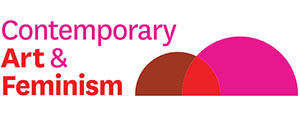Jacqueline Millner (1999)
Throughout Western culture, the ageing woman has been characterised as a problem. Her behaviour, described by Freud as ‘peevish, argumentative and sadistic’, has come to legitimise the social ostracism she suffers:
The older woman evokes in herself and in others the horror and fear of an inappropriate and transgressive sexual desire that lingers through the very process of ageing, physical degradation and decay. Objectively viewed, she is ludicrous, grotesque, sloppy, self-pitying, and abjectly needy; or she is angry, vengeful, powerful, scary. Subjectively felt, she is an excess woman, desperately afraid of invisibility, uselessness, lovelessness, sexual and social isolation and abandonment, but also deeply furious at both the double standard of ageing in a patriarchal culture and her acquiescence to male heterosexist values and the self-contempt they engender. (Vivian Sobchack)
Yet after what amounts to forced exclusion from the sexual economy, to be peevish, argumentative and sadistic is not entirely inappropriate, if that is what it takes to assert one’s bodily and desiring existence. Nonetheless, contrary to Freud’s implication, these traits are not inherent. They are not the natural consequence of impending menopause, but result rather from the manner in which a society regards old age. How is it that the process of a woman’s ageing, which should attest to her fortitude and good health, has come to represent the ultimate abjection? Ella Dreyfus’ three-part exhibition, explores this very question. Featuring close-to life-size cropped nudes, banner-sized diaphanous images of dementia patients and pairs of seated portraits, this work underlines that how we think of old age is directly related to how old age is represented in our culture. And it suggests that perhaps the negative symbolism associated with female old age is not a natural, immutable phenomenon.
The representation of aged women is partly a problem of visibility. The older woman is not easily characterised as either the object or the subject of the gaze; she is often so threatening and disgusting a sight that the gaze quickly slides over her to deny her visibility. Perhaps because the visibly aging body represents a challenge to the self-deluding fantasies of immortality that mark the dominant culture, the aged, in particular women, drop out of public space and the domain of the universal into the desolately private and particular. In their invisibility, their subjectivity is easily denied. In Age and Consent, Dreyfus is concerned to affirm the public presence of the aged, to facilitate the reclamation of some cultural territory for the expression of their experience.
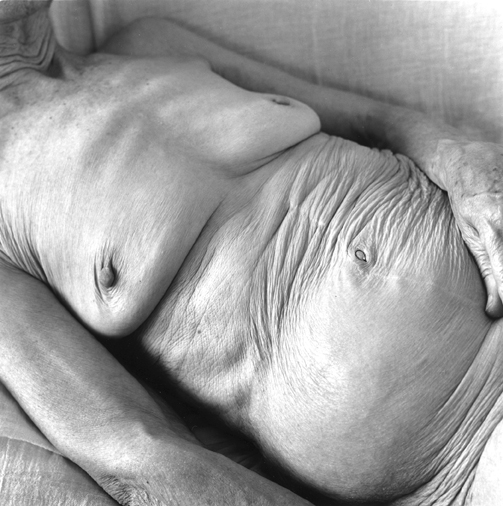
Ella Dreyfus: Age and Consent, 1999
Dreyfus is keenly aware that loss of visibility often goes hand in hand with loss of agency, and even eventual loss of identity. This the artist poignantly captures in the series of signatures, many fractured and incomplete, which she gathered from some of her subjects whose jagged and brittle Copperplate embodies their desperate effort to retain some integrity. Loss of agency also resonates in the fact that we do not choose old age, that our bodies elude our control and change without our consent. Moreover, a body which corresponds to cultural stereotypes of what is ‘feminine’ is generally crucial to a woman’s sense of herself as female and as an existing individual; to exceed the boundaries of the properly feminine through old age may well precipitate a shattering loss of identity. After all, ‘the body by which a woman feels herself judged is the body of early adolescence, slight and unformed, a body lacking flesh and substance, a body in whose very contours the image of immaturity has been inscribed’.( Sandra Lee Bartky) Dreyfus’ images ask us to consider what happens to our sense of self when our body no longer matches this narrow stereotype of femininity.
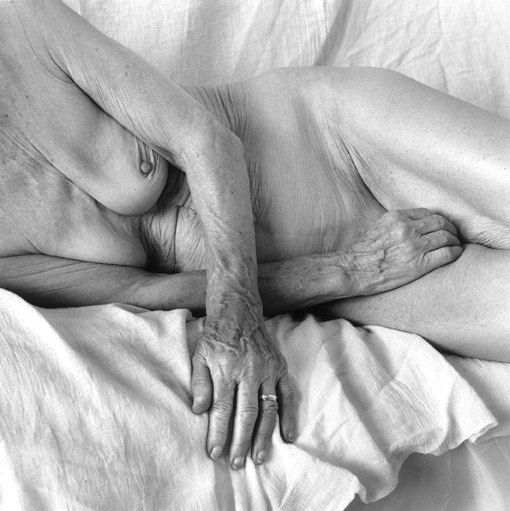
Ella Dreyfus: Age and Consent, 1999
But Dreyfus is not concerned solely with visibility. How a society and individual women themselves portray old age, in what contexts, according to which conventions and cultural codes, to expound which values and ideologies, are also key aspects of her project. Rarely are older women featured in popular culture other than as the butt of humour or the object of pity or loathing. We may never encounter images of the naked aged body outside specialised medical discourse. And while the history of western art may well be in large part the representation of the human form, old women do not really feature in the pantheon of ‘The Nude’, certainly not in accordance with the conflation of the female nude with beauty and desirability. So when we come across monumental images of ageing nudes in the art gallery, we are confounded.
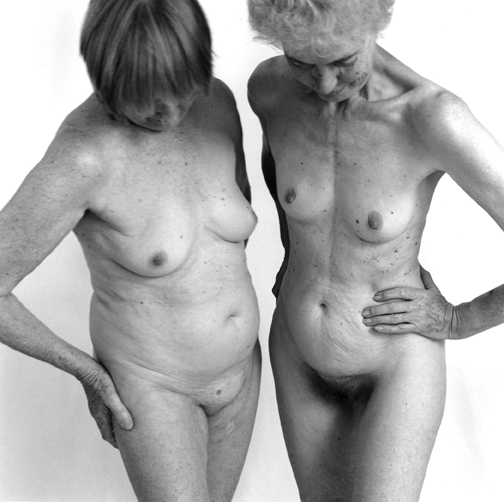
Ella Dreyfus: Age and Consent, 1999
As in her Pregnancy series (1992), Dreyfus appeals to a classical aesthetic, to well-tried conventions of representing the nude: the figures are headless and decontextualised, the poses at times reminiscent of odalisques familiar from art history. Moreover, the artist is clearly concerned with the creation of beautiful prints. Some of these images recall Edward Weston’s nudes, or even the erotic ‘making strange’ of Man Ray. However, Dreyfus’ nudes are not the blemish-free abstractions that invite the projection of heterosexist fantasy. They are marked and worn, most decidedly lived bodies with individual life histories and stories to tell. Messages are scrawled on every inch of skin: thank-you notes, psychological reports, birth certificates, valentine cards. These bodies are, in the words of Carla Kirkwood, journals in 3-D, chronicles of time, of family, of class, of gender, of nation, testimonies to history. The lived experience of these women also over-determines the poses they assume. In the seated portraits we see vestiges of that unspoken imperative that women should take up as little space as possible, knees together, back straight, hands demure. But this language of subordination is not as evident in the nudes, where we see the women becoming looser, loucher, extending beyond the boundaries of the proper. Dreyfus invites us to explore what happens to the artistic/photographic conventions of representing the nude when the body departs from the ideal of beauty.
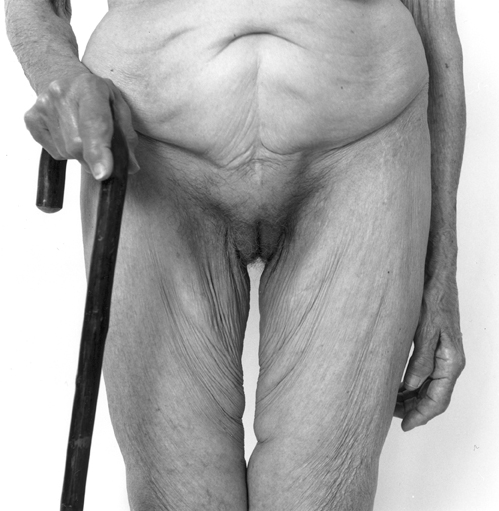
Ella Dreyfus: Age and Consent, 1999
Both in its stated purpose and its look, Age and Consent hovers between art photography and documentary. Documentary photography is often deployed in the cause of social reform, although no longer unproblematically, given concerted critiques of photography’s exclusive purchase on the real. As Abigail Solomon-Godeau points out, oppositional documentary practices operate within larger representational systems that usually go to limit, contain, and even neutralise them. For example, documentary photography often falls prey to the same passive contemplation or voyeuristic consumption associated with mass media that it pits itself against. Dreyfus is well aware that severing negative symbolism from female old age is a far more complex task than the exhibition of positive images. For this reason, her project is as attendant to process as it is to the final product. Dreyfus here has predominantly photographed friends, relatives, neighbours and acquaintances. She has entered into intimate dialogue with these women, listened to the tales around their scars, empathised with their fear and anger at social exclusion. And she has throughout the compilation of images scrupulously conferred with her subjects, granting them veto rights over the photos. In a sense, Dreyfus’ process is a complex collaboration, a subtle exercise in empowerment, and hence radically distinct from ‘socially concerned’ victim photography, and the presentation of the exotic or bizarre for the audience’s titillation.
Combining erudition in codes of representation, sensitivity to the plight of elderly women, and a passionate belief in the power of art to precipitate change, Dreyfus has conceived a poignant and exuberant exhibition. Age and Consent is aesthetically alluring, bold in its statement and undeniably empowering to those many women whose existence is all but denied by the dominant culture. It effectively plays out the aged woman’s real revenge: to insist she is alive, in the world, and ever full of desire.
Text copyright Jacqueline Millner, 1999
Photographs copyright Ella Dreyfus, 1999.
All images are from her exhibition Age and Consent
(Stills Gallery, Sydney and Campbell Mahony Gallery, Brisbane, 1999).
For more information about this exhibition visit www.elladreyfus.com

